공지사항
-
- '노란봉투'캠페인/국제연대..
- no chr.!
2251개의 게시물을 찾았습니다.
1. MTU's Solidarity Night (3.24)
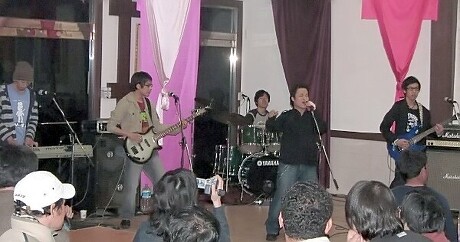
According to a report on MTU's web site about 500 people - migrant workers and Koren activists - joined the event!!

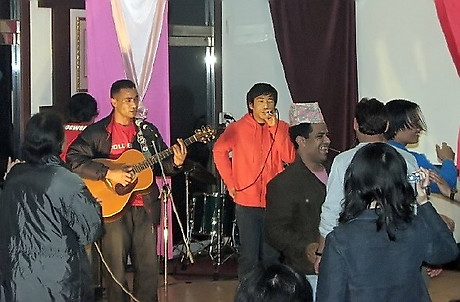
For a report in Korean, incl. more pics:
*****
2. Rally against the current RSOI (3.25)
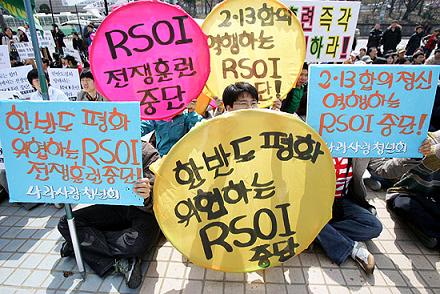
About 700 activists joined the rally..
☞ 용산 미군기지 앞서 'RSOI/FE연습 규탄' 범국민대회
☞ 2007 RSOI/FE 연습 오늘부터 시작, 서울 한반도 평화실현 국민대회
Related article:
☞ S. Korea, U.S. start annual military drills (Yonhap)
*****
3. Mass protest against RUK-US FTA (3.25)
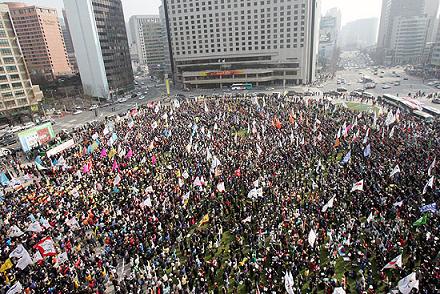
According to several Korean reports between 15,000 and 20,000 people joined it. And - if I remember well - took over for the first time since years the area in front of the US embassy for a final protest rally!!
"On Sunday, about 10,000 South Korean farmers, workers and supporters rallied and marched in downtown Seoul, asking their government to stop the FTA talks.
"No to S. Korea-U.S. FTA," the protesters shouted, as they marched several blocks toward the presidential office Cheong Wa Dae.
The protesters sporadically clashed with riot police blocking their march near the U.S. Embassy. There were no reports of arrests or injuries.
Opponents said they will continue protests throughout this week's Seoul talks." (Yonhap)
☞ Rally against S.K.-U.S. trade deal.. (Hankyoreh)
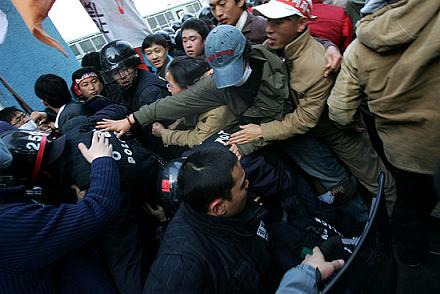
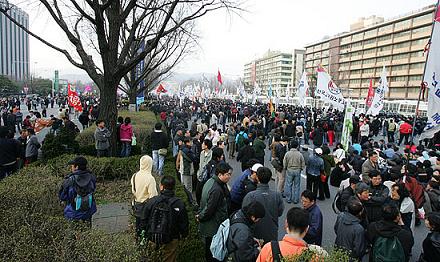
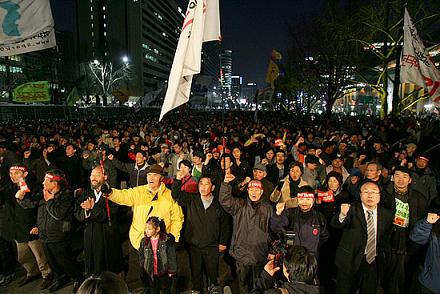
☞ 2만여 한미FTA 반대 시위대, 미대사관 앞 점거 (VoP)
☞ 한미FTA저지 목소리, 진정 불법입니까 (Chamsesang video report)☞ '한미FTA 반대' 시위대, 경찰과 충돌 없이 해산 (OhmyNews)
☞ 20070325 -- 한미 FTA를 반대합니다 (pics by "땅의 사람")
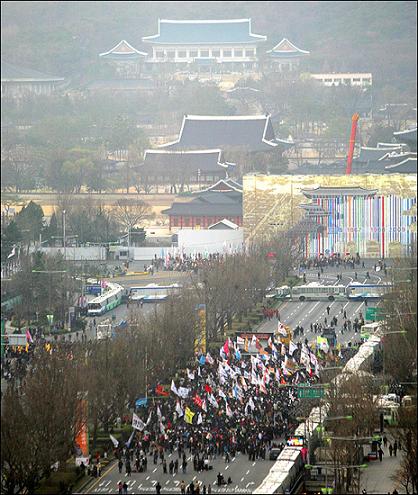
TOMORROW: MTU'S SOLIDARITY NIGHT
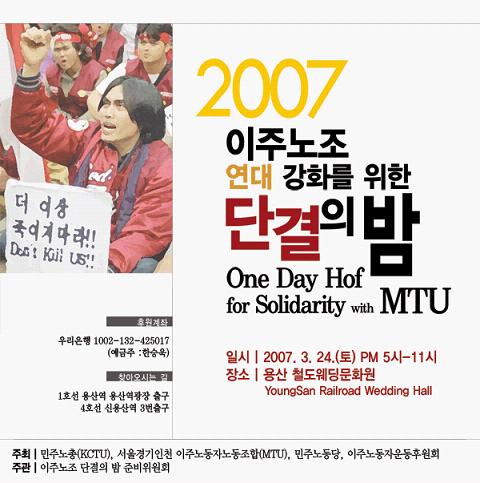
Uhuu, I'm sorry that I'll not be able to join the event..^^
When I was active in ETU-MB, our labour union before MTU was established in spring 2005, I had the possiblity to join several Solidarity Partys..
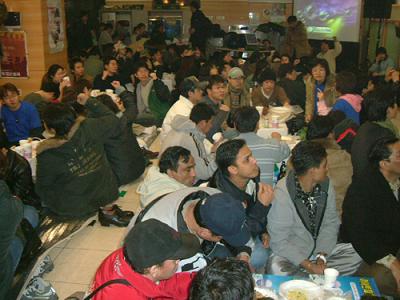
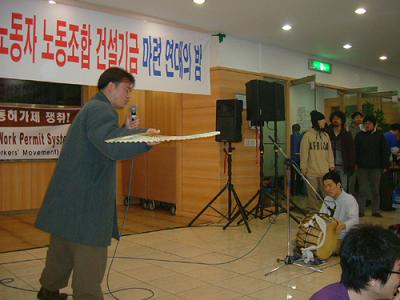
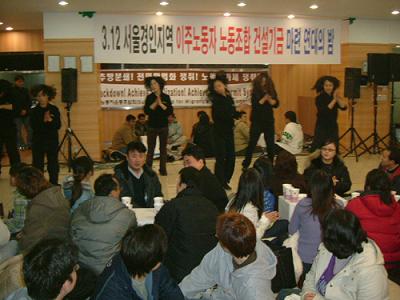
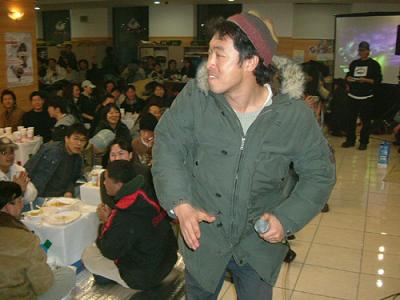
Solidarity Night, 2005.3.12
About that event I reported following:
"Actually it needs not many words to describe the atmosphere on our - migrant workers' - yesterday's solidarity night (perhaps, when you see the following pictures, you can imagine...). Since the afternoon hundreds of sympathizers and supporters of our struggle came to the Korea University to join the event.
Beside many cultural highlights, such as the protest singers Yeon Yeong-seok and Park Joon, several student expression dance groups, a song group from Burma and a mixed - migrant workers and Koreans together - "agit-prop" group from Ansan.."
If you want to get some more impressions about previous events you should check out:

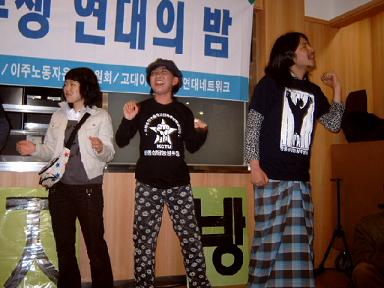
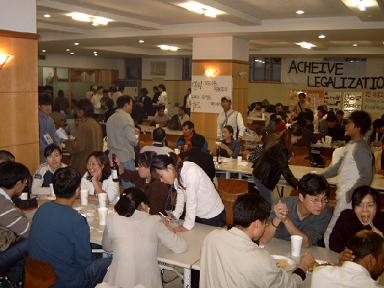
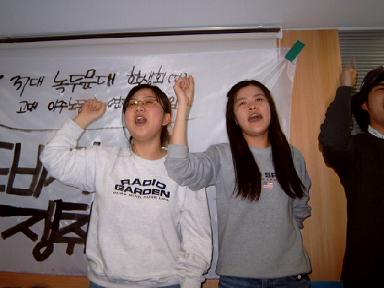
ETU-MB's Solidarity Night 2004
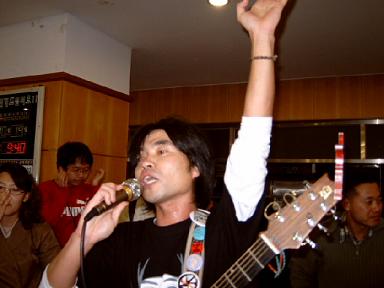
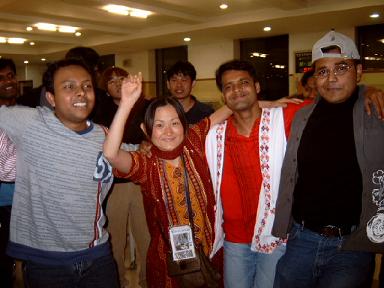
Soli-Night 2003
PS:
But (of course) MTU's Soli-Night is not all what's going on this (coming) weekend in Seoul:
(가칭)한반도 전쟁위협 RSOI/FE 전쟁연습 반대와 평택미군기지 전면재협상 촉구 대회
일시 : 3월 25일 오후1시부터
장소 : 서울 용산미군기지 앞

The nuclear-powered aircraft carrier U.S.S. R. Reagan
now in Busan
Related articles:
☞ 07' RSOI/FE연습 美 증원군 6천명 참가 (Tongil News)
☞ US Nuclear-Powered Aircraft Carrier to Join Drills (K. Times)
☞ U.S. to Mount Military Exercises with S.Korea (Chosun Ilbo)
☞ RSOI&FE가 중단돼야 하는 이유 (VoP)
And just a short while later (also Sunday) following will be happen:

And last but not least:

India: The Ongoing People's War
It's (likeley) well-known that in India since decades - at least since the late 1960's - several communist organisations, guided (of course) by M/L, but also more or less by the Mao Zedong-ideas (the so-called Naxalites are the most known..) are fighting, also armed, for the liberation - some just simply for democracy (because in many regions of this country still the feudalism is ruling). But while during the 1970's/80's many leftwing groups, especially in the west, were reporting about the struggle in India, nowadays - even the People's War (P.W.) is continuing/partly increasing - it's very quiet about that issue.
Last Tuesday (3.20) Asia Times (China/HK) published following interresting article about the recent developments on the front line of the P.W. in India:
India's Maoists take their war to a new level
 India's Maoist rebels, known as Naxalites, have scored a series of successes in recent weeks in their insurgency, underscoring their growing ambitions and changing strategy, and stoking fears of attacks on high-profile and urban targets in coming months.
India's Maoist rebels, known as Naxalites, have scored a series of successes in recent weeks in their insurgency, underscoring their growing ambitions and changing strategy, and stoking fears of attacks on high-profile and urban targets in coming months.
Last Thursday, they attacked a police post in the central state of Chhattisgarh, killing 55 people. A fortnight earlier they assassinated member of Parliament (MP) Sunil Mahato in neighboring Jharkhand state.
Last week's attack, described as among the deadliest in decades of Maoist insurgency, was carried out by some 350 heavily armed Maoists. It took place in Rani Bodli police outpost, in Chhattisgarh's Dantewada region, some 525 kilometers from the state capital, Raipur. The rebels surrounded the police post and lobbed grenades and gasoline bombs before setting the camp ablaze.
They blocked roads to the village by felling trees to prevent police reinforcements from reaching the heavily outnumbered police at Rani Bodli. Of the 55 killed in the attack, 16 were members of the Chhattisgarh Armed Police. The rest were Special Police officers - tribals who were part of the government-sponsored civil militia, the Salwa Judum.
The assassination of Mahato and the attack on the Rani Bodli police outpost signal a sharp escalation in the Maoist insurgency. In the past, high-ranking victims of the Maoists included legislators and ministers, but these were at the local and state levels. Mahato was the first sitting federal MP to fall victim to the Maoists.
Again, while police outposts have been routinely targeted by the Maoists, the attack at the outpost at Rani Bodli was noteworthy for the number of victims it claimed. The death toll at Rani Bodli is by far the largest among recent Maoist attacks.
The frequency of such spectacular attacks has grown over the past two years. In November 2005, more than 1,000 Maoists participated in an attack on Jehanabad jail in Bihar and freed about 350 of their jailed comrades. Last March, they hijacked a train in Jharkhand that was carrying some 300 passengers. In June, at least 400 Maoists participated in an attack on a camp of the Central Reserve Police Force in Hazaribagh, Jharkhand.
The scale and frequency of attacks are one concern. Another is the vast area across which Maoists wield influence. In the early 1990s, the number of districts affected by varying degrees of Maoist violence stood at just 15 in four states. This figure rose to 55 districts in nine states by the end of 2003 and shot up to 156 districts in 13 states in 2004. Today, at least 170 of a total of 602 districts in the country are said to be under Maoist influence.
The Maoists have been able to strike with considerable energy because of the unification of the two main groups. The Maoist Communist Center and the People's War Group merged in September 2004 to form the Communist Party of India (Maoists). From operating as scattered localized cells, they have been able to operate as a stronger and unified force along a vast swath of territory often described as the "red corridor" running from Nepal down to Andhra Pradesh state.
Experts warn that the recent attacks signal a widening and intensification in Maoist violence in the country. According to Bibhu Prasad Routray, research fellow at the Institute for Conflict Management in New Delhi, "Mahato's killing could just be the starting point for the escalation of the Maoist 'people's war' throughout the country."
Maoist documents and statements provide pointers to their growing ambitions and changing strategy. In 2004, Maoists, who had hitherto focused their operations in rural India, spoke of a new strategy to target urban centers. Their Urban Perspective Document lay down guidelines for working in towns and cities and for mobilizing support among students and urban unemployed. They identified two belts as targets for urban mobilization: Bhilai-Ranchi-Dhanbad-Kolkata and Mumbai-Pune-Surat-Ahmedabad.
More pointers to their growing ambitions were provided in statements issued at their "Unity Congress" this year. "The Unity Congress ... resolved to advance the people's war throughout the country, further strengthen the people's army, deepen the mass base of the party, and wage a broad-based militant mass movement against the neo-liberal policies of globalization, liberalization [and] privatization pursued by the reactionary ruling classes under the dictates of imperialism," said a statement issued at the meeting last month.
"No more hit and run," Muppala Lakshman Rao (also known as Ganapathi), who was re-elected general secretary of the organization, is reported to have said at the meeting. "Now the time has come to spread in the towns and identify specific targets, hit them precisely and with impunity."
Attacks in urban centers and on high-profile targets can be expected in the coming months.
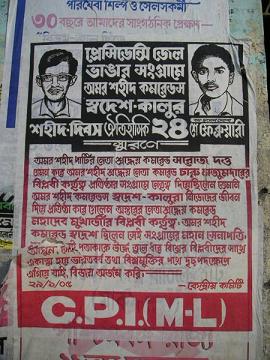 An important trigger and target of Maoist attacks over the past year has been civilians who are part of the Salwa Judum - the Chhattisgarh government's initiative to arm villagers to fight Maoists on behalf of the state. Salwa Judum was initially thought to be a voluntary initiative of villagers in Maoist areas, who were fed up with the Maoist violence and wanted to fight the rebels themselves. It was touted by the government as a peace movement.
An important trigger and target of Maoist attacks over the past year has been civilians who are part of the Salwa Judum - the Chhattisgarh government's initiative to arm villagers to fight Maoists on behalf of the state. Salwa Judum was initially thought to be a voluntary initiative of villagers in Maoist areas, who were fed up with the Maoist violence and wanted to fight the rebels themselves. It was touted by the government as a peace movement.
However, soon it became apparent that while some people in these villages might indeed be weary of violence, Salwa Judum was in fact government-sponsored and a civil militia, and tribals were being forced to join it. While a part of Salwa Judum's work involved political work, ie, propaganda against the Maoists, it also had an armed wing, which was seen as the tribal face of the police fighting the Maoists.
Soon, Maoists started targeting members of the Salwa Judum. Camps in which Salwa Judum members lived or buses in which they traveled were targeted by the Maoists. Hundreds of Salwa Judum members have been killed in the 18 months since it was formed.
The counterinsurgency strategy of the Chhattisgarh government, with Salwa Judum at its core, has unleashed civil strife in the state. Tribals have gotten caught in the crossfire between Maoists and the state. In the past, the Maoists targeted forest officials and police. Now it is tribals seen to be members of Salwa Judum who have become targets of Maoist ire. The 39 Special Police officers who were killed in last week's attack on the Rani Bodli police outpost were part of the Salwa Judum.
Entire villages have been emptied as tribal communities flee from the burnings, lootings and killings. The civil war in Chhattisgarh has driven more than 50,000 people out of their homes and into camps. Government authorities claim that the tribals are seeking refuge in the camps; tribals tell a different story. They maintain that they are forced into the camps.
The land on which the tribals live is rich in minerals and other resources. Human-rights activists say companies backed by the government that are keen to extract the area's mineral wealth want the tribals to leave the land. Salwa Judum has become a convenient way to drive the tribals out of their land and into camps.
http://www.atimes.com/atimes/South_Asia/IC20Df01.html
For more infos:
☞ CPI(M)
☞ CPI(ML)
THE FUTURE OF GAESEONG
INDUSTRIAL COMPLEX
A Perfect Tool for the S.K. Capitalists to
Make Maximum Profits
"If completed as scheduled, the Kaesung Industrial Region will include not only labor intensive ones but also heavy industries and high-tech firms, becoming one of the busiest industrial centers of East Asia." (DailyNK, 3.20).
This development will lead to mass dismissals in S.K. and more massive exploitation of the N.K. working class!
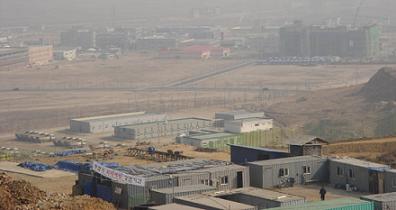
Following article, published in today's Hankyoreh gives just one simple example of the likely future (if the S.K. capitalists and their collaborators in the DPRK are able to achieve their goals without the resistance of the Korean working class!!):
S.K. textile industry looks to joint
North-South industrial park
Combination of low wages, high skills cited by companies ’moving North’
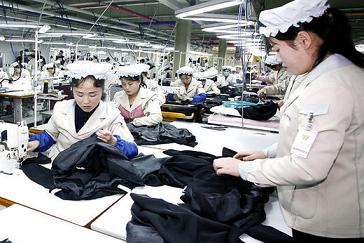
Seo Sang-ik, 77, chairman of mid-size clothing company BMX, has been seriously considering moving his production facilities to the joint North-South Korean Gaeseong (Kaesong) Industrial Complex, located just across the border in North Korea.
Having worked as a businessman for over 40 years, Seo judges the Gaeseong park, with its reportedly low wages and highly skilled workers, as a way to ensure a bright future for his company.
Seo has operated a clothing factory since the 1970s. At that time, South Korea’s textile and sewing industries were representative exports of the nation. But since the 1990s, an increase in wages has elevated the standard of living but also cost the nation its competitive edge in the textile industry. To try to stay afloat, Seo built a factory in Guatemala, and another in Dalian, China. However, he was unable to keep the Guatemala factory open, and the situation in China has greatly changed, as well, with Seo finding it hard to find workers. He blames this on the Chinese government’s attitude toward textiles as a "low value-added" industry in the midst of its feverish push to become an economic superpower. In addition, wages have risen in China, so that Seo finds he has to pay a minimum monthly wage of US$150 per worker.
"I heard that wages for [North Korean] workers at the Gaeseong Industrial Complex are as low as $57 a month, and that the workers have higher skills than those in China," said Seo.
A Gaeseong fever has been sweeping the South Korean textile industry. Since the February 13 agreement on ending North Korea’s nuclear programs, the draw has become even stronger.
Ahead of an additional sale of business spots at Gaeseong next month, more than 200 companies took part in a seminar about the industrial complex held March 7-9 by the Korea Federation of Textile Industries. Up to 86 firms submitted applications to move their factories to the Gaeseong complex, out of 32 slots.
The textile industry has honed in on the Gaeseong Industrial Complex due to the remarkable performance of firms which moved into the model complex in Gaeseong last year. Shinwon Corporation recorded an operational surplus after eight months, citing the harmoniousness of relations between management and labor. The company’s Gaeseong productivity levels are approaching nearly 80 percent of the productivity at its South Korean factories. Moonchang Industry, a uniform-maker that supplies larger brand-name companies, has also been very successful in Gaeseong.
Park Chang-ryeol, an official of the Korea Federation of Textile Industries, said that with Moonchang Industry’s success, large companies also have positively been recommending their subcontractors move into the Gaeseong Industrial Complex.
Indeed, Gaeseong has become the ultimate choice for survival for a number of textile companies.
"Even the best companies with state-of-the-art equipment won’t be able to survive [in South Korea] after two or three years because of the increase in cost and the banks’ concept of textiles as a declining industry," warned Kim Yeong-geol, an executive of a cooperative for textile companies in Seongnam, Gyeonggi Province, South Korea. About ten of the 46 member firms of the cooperative hope to move to Gaeseong, he added.
In fact, the first companies to head to Gaeseong were largely in the textile industry. These companies are occupying a large portion of the already full-to-capacity model complex and main complex of the industrial park. The reasons for the growth of this ’textile city’ are severalfold. The textile industry is labor-intensive and doesn’t need advanced machinery, which cannot be brought into North Korea because they are classified as "strategic goods." Moreover, products whose simple needlework is done in the Gaeseong complex can still be recognized as South Korean-made goods in overseas markets as long as the fabric and materials originate from South Korea.
However, the vision of the textile industry is not solely a rosy one. The companies there are worrying about a potential imbalance of labor supply and demand. Most textile companies seek skilled female workers in their 20s or 30s, but the Gaeseong complex has only less than 20,000 of such workers available, a number expected to not keep up with demand. Complicated customs procedures for bringing materials in and products out of North Korea is another detriment to working at Gaeseong.
Overall, however, the Gaeseong Industrial Complex has a potential to grow into an important world textile hub, some industry observers say. "To compete with Chinese-made goods, the Gaeseong complex should become a complex for the textile industry, complete with all procedures from yarn to spinning, dyeing, and sewing," said Park Hun, a researcher of the Korea Institute for Industrial Economics and Trade, adding that "for maximization of cost efficiency, companies should be allowed to access nearby ports as well as land routes."
http://english.hani.co.kr/arti/english_edition/e_business/197551.html
Related article:
☞ Analysis of Kaesung Industrial Region's Future (DailyNK, 3.20)
To check out the subject:
☞ Gaeseong Industial (i.e. Exploitation) Complex
Updated (see below: related articles/videos)

Surprise, surprise:
Yesterday some thousands demonstrators took the streets of Seoul to protest against the planned US-ROK FTA. And the S.K. gov't responded with.. POLICE TERROR!!
Even - for example - the Israeli media, such as Ynet/Yedioth Ahronoth

wrote about it:
South Korean riot police break up protest against US free trade agreement
Published: 03.10.07, 14:37 / Israel News
Riot police used a water cannon Saturday to break up a noisy but peaceful street protest in downtown Seoul against a proposed free trade agreement between South Korea and the United States.
Police armed with shields and truncheons fired several bursts from a water cannon into the crowd of about 2,000 protesters, mostly farmers, workers and students, after they ignored a warning to disperse as temperatures dropped to freezing in early evening.

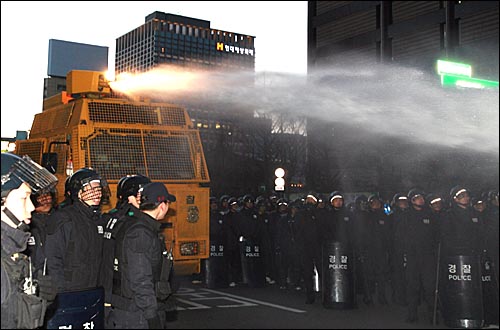
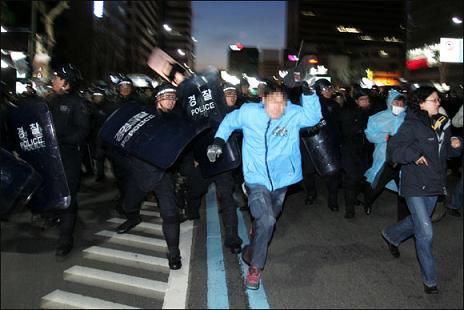
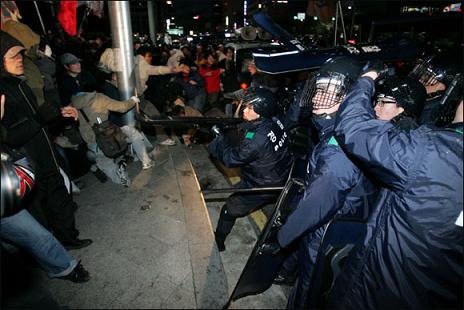
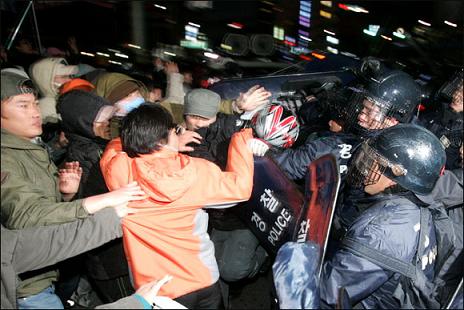
Sorces of the pics: OhmyNews, VoP
Reports in Korean and English:
☞ Chamsesang (Korean, incl. videos)
☞ Voice of People (Korean, incl. videos)
☞ Tongil News (Korean)
☞ OhmyNews (Korean)
☞ Pressian (Korean, incl. videos)
☞ OhmyTV (Korean, video)
☞ Korea Herald (English)
☞ The Hankyoreh (English)
☞ No-FTA Newsletter (English)
PS:
In my opinion.. what was happen y'day, it might be just the pre-play what we (yeah, I know..) have to expect when the next gov't will be "ruling" - if we can't prevent this f.. sh..!! - S.K.
Mass rallies against S. Korea-U.S. FTA set for Saturday
Defying a ban (yeah, in advance announced POLICE TERROR!!) anti-globalization activists prepared to hold a mass rally here Saturday to oppose a proposed free trade agreement (FTA) between Seoul and Washington, police said Friday.
About 6,000 people are expected to participate in the street rallies in downtown Seoul, the Seoul Metropolitan Police Agency said. (Yonhap)

한미FTA저지 1차 범국민 총궐기대회
- 일시 : 3월 10일(토) 오후2시
- 장소 : 서울시청 광장
The rally, demo (??) and ... (??!!!) will take place:
Sat., 2 p.m.
Seoul, City Hall Plaza
(according to KCTU)
INTERNATIONAL WOMEN'S DAY
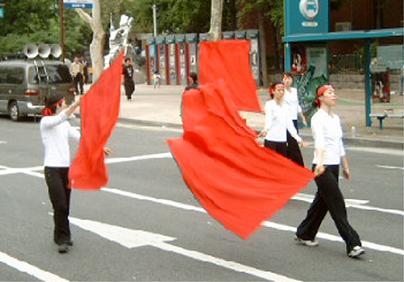
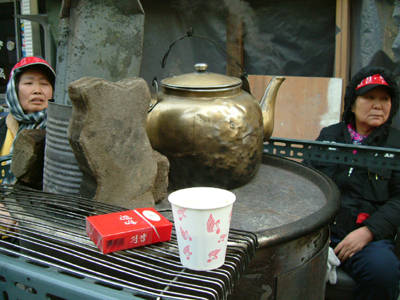
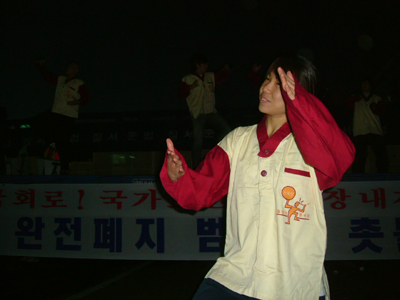
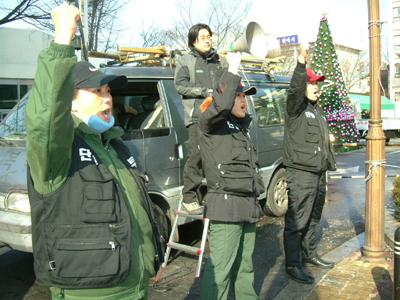

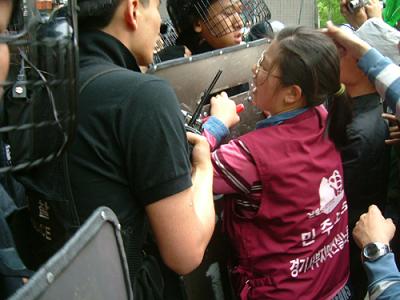
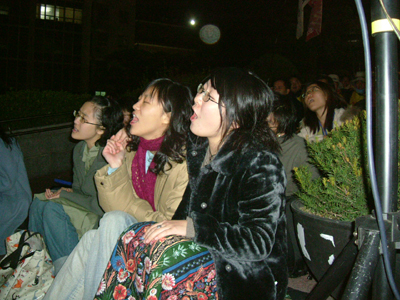
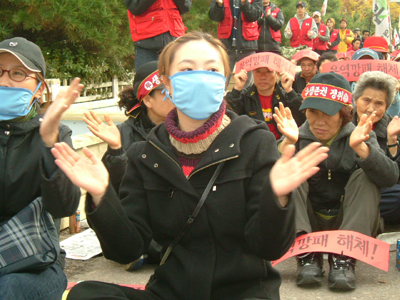

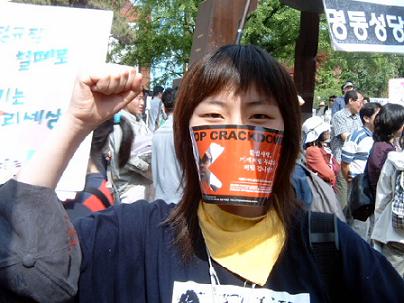

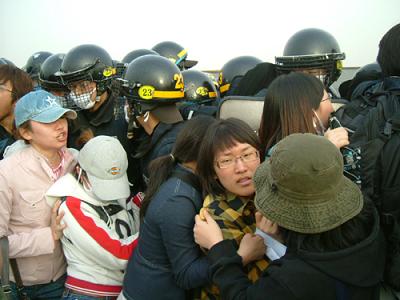

*****
Related (^^):
DPRK propaganda (KCNA) about the..
☞ Model of Korean Women in Songun Era

"What a f.. reactionary sh..!!!"
SMASH THE
'NATIONAL "SECURITY" LAW'!!
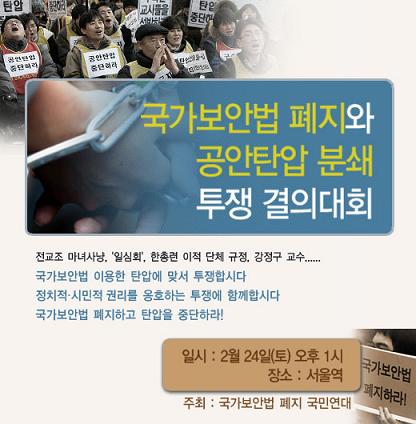
Related:
☞ 국가보안법 폐지와 공안탄압 분쇄 투쟁 결의대회에 함께합시다
*****
And please remember: just one day later (Sunday, 2.25, 2 pm), at the same place (Seoul Stn.) the Migrant Workers' protest rally will take place!!!
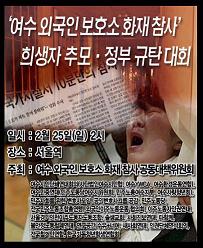
Related:
☞ We are all ‘foreign workers’ (Hankyoreh, 2.16)
☞ 이주노동자단체들, "우리는 범죄자가 아니라 인간" 하소연 (VoP)
☞ How many more? Continuing death of migrant workers
☞ Who killed 9 chinese workers?
☞ After Yeosu.., immigrant workers raise their voices (Hankyoreh, 2.24)
☞ 2.23 여수시청 앞 '여수 화재참사' 추모집회 (VoP/incl. video report)
Former U.S. Secretary of Defense William James Perry on Thursday called an inter-Korean industrial complex in Kaesong, North Korea, as the ``future of the Korean Peninsula.’’ (K. Times, 2.22)
Yeah, the S.K. capitalists may like this idea:
- monthly payment for the workers: max. 50,000 Won ($50)
- labour unions are definetely not allowed
- no labour rights at all..
- and if the workers are choosing resistance: Yodok is just waiting for them..
etc...
For more possibilities for maximum exploitation:
☞ Gaeseong Labour Camp, aka 개성공업지구관리위원회

"Hartz-4-fate(*)
I must sell my blood to
survive"(**)
* Hartz 4: German law to spend (by the office of "labour") for unemployed persons (345 Euro per month)
** The front page of BZ, THE MAIN "yellow press" newspaper in Berlin - one week ago, last Saturday, 1.13
If you follow even the German bourgeois media, such as the TV station ZDF, it will be just the beginning of the future, especially for the older people (at least over 50-years-old) without a regular work (nowadays several Millions..)
♦ Check out this (just the first two verses of "2. Marsch der Mumien"!!):
http://memolog.blog.naver.com/nosugaradded/145
최근 덧글 목록